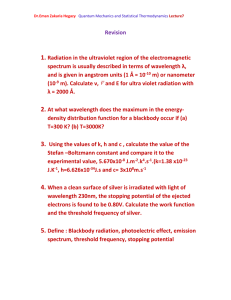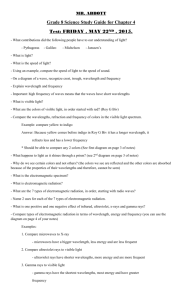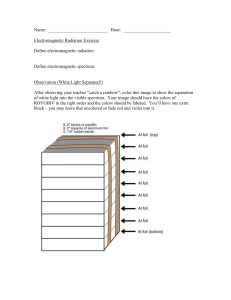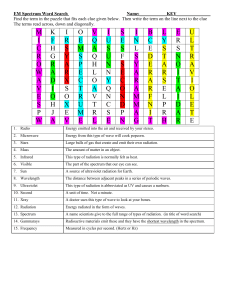Chapter 7 Light
advertisement
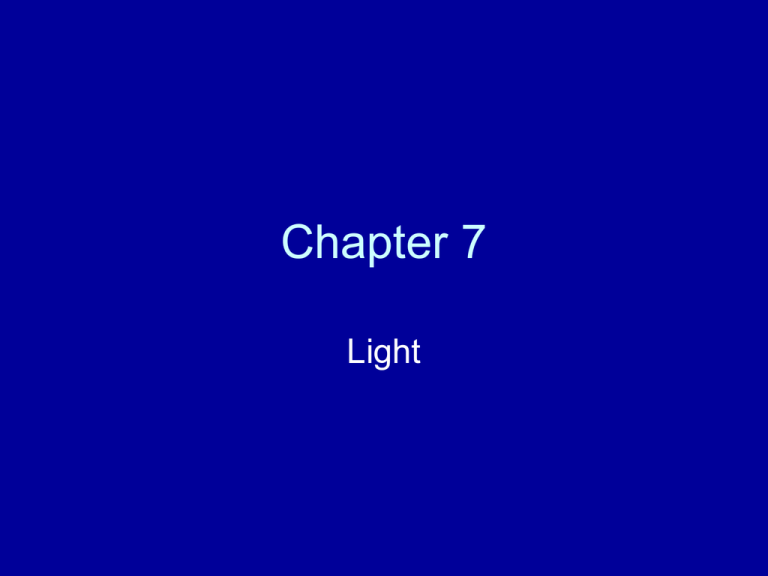
Chapter 7 Light Some definitions • Luminous: Something that produces light. The sun is a luminous object that provides almost all the natural light on the earth. • Incandescent: Visible light given off as a result of high temperatures. e. g. light bulb, a flame. Electromagnetic Wave When an electric charge is accelerated by some external force the acceleration produces a wave consisting of electric and magnetic fields that become isolated from the accelerated charge. As the wave moves through space, the two fields exchange energy back and forth, continuing on until they are absorbed by matter and give up their energy. These waves move at a speed of 300,000,000 meters per second, known as the speed of light, or “c”. The units for wavelength are m or cm. Fixed point in space Frequency (f) is how many times per second the crest of a wave passes through a fixed point in space. The units are in cycles per second. Electromagnetic Spectrum Increase Frequency (f) Decrease Wavelength (λ) Frequency and Wavelengths • Speed of EM wave 3x108m/s (c). This is a constant value. • Relationship between wavelength and frequency: • λxf=c Wavelength and frequency inversely related λ (wavelength) = c / f f (frequency) = c / λ Energy of an EM wave • Higher frequencies (shorter wavelengths) means more energy. • E=hxf • h is Planck’s constant. • Since frequency (f) and wavelength (λ) are inversely proportional, then higher energy means lower or shorter wavelengths. Radiation is given off by matter at any temperature. This is called black body radiation. Near absolute 0 (0K),there is little energy available and no radiation is given off. As the T of an object is increased, more energy is available, and this energy is distributed over a range of values, so more than one frequency of radiation Is emitted. As the T increases the peak frequency (more abundant) becomes higher, since there is more energy available. Radiation • At room temperature, the radiation given off from an object is in the infrared region (heat), invisible to the human eye. When the temperature of the object reaches about 700oC, (about 1300oF), the peak radiation is still in the infrared region, but the peak has shifted enough toward the higher frequencies that a little visible light is emitted as a dull red glow. As the temperature of the object continues to increase, the amount of radiation increases, and the peak continues to shift toward shorter wavelengths. The object begins to glow brighter and the color changes from red, to orange, to yellow, and eventually to blue and then white. • The incandescent flame of a candle or fire (approx. 2700 oF ) results from the blackbody radiation of carbon particles in the flame. The tungsten filament of an incandescent light bulb is heated to a higher temperature by an electric current (~ 4000 oF), and as a result the visible light emitted is brighter (more white). • The radiation from the sun, or sunlight, comes from the sun’s surface, which has even higher temperatures (approx. 10000 oF). Blackbody Radiation • Electromagnetic radiation is given off from matter at any temperature. This is called blackbody radiation. • The radiation originates from the acceleration of charged particles near the surface of an object. The frequency of the radiation is determined by the temperature of the object. Energy of an EM wave • Sun’s temperature 6000K, • UV, Visible and IR enter our atmosphere. The sun’s radiation has a broad Spectrum centered near the yellow-green frequency. Your eye Is most sensitive to this frequency of sunlight. The spectrum of sunlight before it travels through the earth’s Atmosphere is: Infrared ~ 51% Visible light ~ 40% UV light (ultraviolet) ~9% Sunlight originates as energy released during nuclear reactions in the sun’s core. This energy requires about a million years to work its way up to the surface. At the surface, the energy from the core accelerates charged particles, which then emit light like tiny antennas. The sunlight requires about eight minutes to travel the distance from the sun’s surface to the earth. Fig. 7.5 Properties of Light • You can see luminous objects from the light they emit and you can see non luminous objects from the light they reflect. • You cannot see the path of light itself. You cannot see a flashlight beam unless you fill the air with chalk or smoke. The dust or smoke reflect light, so you see the path of the beam. A ray of light travels in a straight line from a source until it encounters an object or particles of matter. If the surface is perfectly smooth the rays of light undergo reflection, as in a mirror. If the surface is not smooth, the light rays are reflected in random directions, like dust in the air. Some materials allow much of the light that falls on them to move through the material without being reflected. Materials that allow transmission of light through them are called transparent, like water and glass. Materials that do not allow transmission of any light are called opaque. They reflect light, absorb light, or some combination thereof. The reflected light gives rise to the perception of color. Color • Visible light is the part of the electromagnetic spectrum that your eyes can detect. It is a narrow range of wavelength. This can be subdivided into ranges of wavelengths that you perceive as colors. These are the colors of the rainbow, and there are six distinct colors, red, orange, yellow, green, blue, and violet. • Light can be interpreted to be white if it has the same mixture of colors as the solar spectrum. It is a mixture of all the independent colors. • Isaac Newton found that a beam of sunlight falling on a glass prism in a darkened room produced a band of colors he called a spectrum. • Black is the absence of all colors. Why is the sky blue? • A clear cloudless day-time sky is blue because molecules in the air scatter blue light from the sun more than they scatter red light. When we look towards the sun at sunset, we see red and orange colors because the blue light has been scattered out and away from the line of sight. • The molecules of oxygen and nitrogen in the air are sufficient to account for the scattering. Questions Chapter 7 • p. 201-202 Applying the Concepts, # 1, 2, 3, 4, 9, 14, 17 • New Book: p. 217-220 # 1, 2, 4, 6, 11, 13, 22, 23, 24, 27, 31, 34, 35, 36, 37, 38, 40, 41, 42, 49. Review Chapter 7 • • • • • • • • • • • Luminous and incandescent. Blackbody radiation-given off at any temperature by objects. Electromagnetic waves. Speed of light, frequency, wavelength, amplitude, troughs, crests. Components of the electromagnetic spectrum: gamma rays, X rays, UV, visible, microwave, infrared (heat), radio and TV. This is the order of increasing energy and frequency, decreasing wavelength. Relationship between frequency (f), λ wavelength (λ), and the speed of light ( c ). Relationship between frequency and energy. (Planck’s equation) Variation of energy of electromagnetic radiation with temperature. Transmission, absorption, reflection of light, transparent and opaque objects. Color is the visible portion of the electromagnetic spectrum. White is the mixture of all colors. Black is the absence of colors. Color of the sky-Blue light is reflected more by the O2 and N2.
